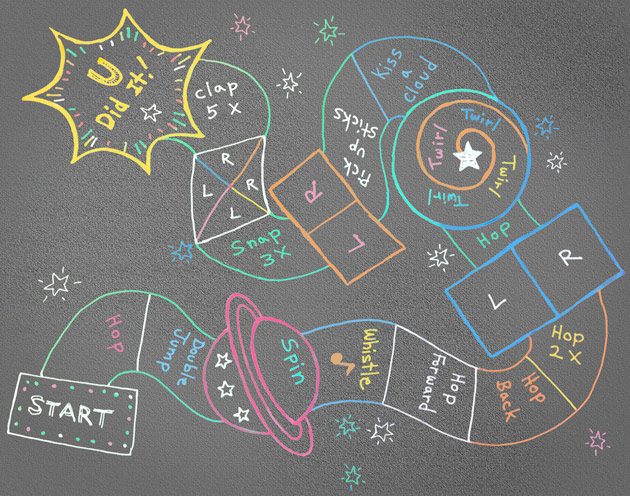
In my childhood I found the flat sidewalks of Chicago made hopscotch a fun option for kids with nothing to do. The classic game of active amusement could become a neighborhood tournament through creative innovation back then. Kids at play often reveal astonishing creative talents.
Hopping With Holly
Holly, a friend from those days, told me about the summer she stayed with her aunt and had no place to play. But she befriended the girl who lived next door.
They found some chalk and drew a hopscotch course on the sidewalk. They played every day, and invented new hopscotch courses with twists and turns and challenging passages. Soon other kids were joining in.
By midsummer Holly and her friend had organized daily hopscotch contests and even gave out award certificates they made themselves.
With a stick of chalk and a lot of creativity Holly and her friend turned that summer into something special.
A Hop, Skip, and a Jump Up
I don’t know what became of Holly, but I do know about Barbara, who displayed similar talents on the sidewalks of Edgewater, N.J.
Barbara Corcoran is a Manhattan “real estate queen” and a star investor on the popular TV show, “Shark Tank”. I admire Barbara as a creative hero.
As a child, Barbara used imaginative elaboration to turn the simple game of hopscotch into a neighborhood marvel. She thought up original hopping challenges and gave the course an exciting new name. She had the moxie to make up her own rules, too.
Fast forward to adulthood: Barbara used her creative thinking strengths to advantage as she rose to incredible success.
In her book, “If You Don't Have Big Breasts, Put Ribbons on Your Pigtails: And Other Lessons I Learned from My Mom,” Barbara writes:
“My hands were covered with chalk as I finished my masterpiece. ‘The Largest Sidewalk Snail Game In the History of the World!’ The Snail wriggled up and down the sidewalk, over the curb, and onto Undercliff Avenue. It stretched from Mrs. Rinehold’s house, past Mrs. Gibbons’, and right up our front steps.
“Square after square of symbols and shapes showed the neighborhood kids exactly what to do as they hopped onto each space: first with two feet, then one right foot, and the next commanding a left foot in reverse. Next came one of my tricky spirals I call ‘spinners,’ followed by a dozen other variations on and on to the end.
“Kids began lining up for their turn….”
She continues, “‘Mom!’ I blurted, trying to catch my breath. ‘Michael Mertz says I can’t change a square in my Snail Game. Can I?’
“‘It’s your game, Barbara Ann,’ she said, …..’ So make up your own rules.’”*
Barbara tells about using her imagination to see herself in the successful role she would later attain.
“As a kid, I was made to feel like an outsider because I was different. In business, I’ve become known as an innovator because of that difference. What Sister Stella Marie called ‘stupid,’ I would later discover was ‘dyslexic.’ I’ve since learned that children who struggle with written information and facts almost always have great imaginations. They can see the big picture, think outside the box, and with just a little encouragement, can learn to use their fertile imaginations to fill in the blanks. Although I’m still a painfully slow reader, I can read a person, size up a situation, and invent a new idea quicker than a wink.
“My mother was wise enough to identify my special gift of creativity and underline it. In doing so, she turned my ‘stupidity’ into my greatest strength. I’ve succeeded because of my learning difference, not despite it.”*
The Creative Genius At Play
Buds of creative genius often show in the way children play. Creativity is about problem solving in a new way, making new connections, and using imagination. Dr. E. Paul Torrance identified four basic components of creative thought, which tend to interact in various combinations with each other. Those components are fluency, flexibility, originality, and elaboration. I wrote about these in a blog post here.
Observe your kids at play and notice if they use creative thought to excel at any particular games. Watch as they strategize or come up with surprising ways to outwit other players. Perhaps they generate more ideas than other players. Be impressed, also, if your kids make up their own wildly imaginative games, elaborate on games, or invent variations of existing games.
Look for creativity as it appears and encourage your child to become an innovator and rule changer in life.
I wrote more about creativity in children’s games, including a list of both popular and unusual games that provide a creative workout, at Creativity Portal: “Creative Talent Comes Out To Play”.
Which games do your kids enjoy playing? Have you observed any creative skills while they play? Share your comments.
*Barbara Corcoran, “If You Don’t Have Big Breasts, Put Ribbons On Your Pigtails: And Other Lessons I Learned from My Mom” Penguin Group, New York, NY, 2004, pgs. 30, 72 – 73 (Published in hardback as “Use What You've Got, and Other Business Lessons I Learned from My Mom.”)